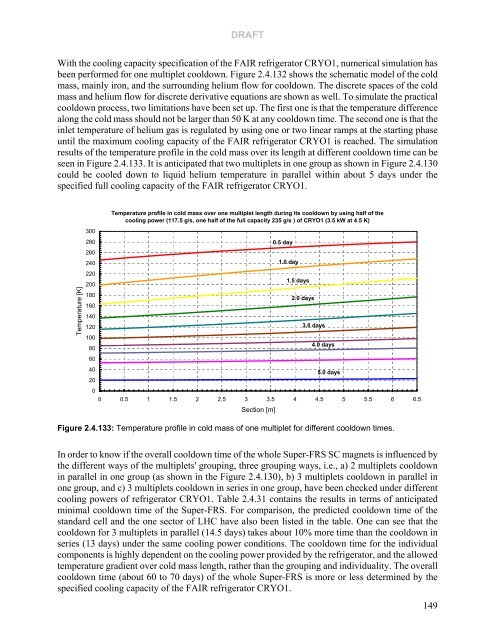Technical Design Report Super Fragment Separator
Technical Design Report Super Fragment Separator
Technical Design Report Super Fragment Separator
You also want an ePaper? Increase the reach of your titles
YUMPU automatically turns print PDFs into web optimized ePapers that Google loves.
DRAFT<br />
With the cooling capacity specification of the FAIR refrigerator CRYO1, numerical simulation has<br />
been performed for one multiplet cooldown. Figure 2.4.132 shows the schematic model of the cold<br />
mass, mainly iron, and the surrounding helium flow for cooldown. The discrete spaces of the cold<br />
mass and helium flow for discrete derivative equations are shown as well. To simulate the practical<br />
cooldown process, two limitations have been set up. The first one is that the temperature difference<br />
along the cold mass should not be larger than 50 K at any cooldown time. The second one is that the<br />
inlet temperature of helium gas is regulated by using one or two linear ramps at the starting phase<br />
until the maximum cooling capacity of the FAIR refrigerator CRYO1 is reached. The simulation<br />
results of the temperature profile in the cold mass over its length at different cooldown time can be<br />
seen in Figure 2.4.133. It is anticipated that two multiplets in one group as shown in Figure 2.4.130<br />
could be cooled down to liquid helium temperature in parallel within about 5 days under the<br />
specified full cooling capacity of the FAIR refrigerator CRYO1.<br />
Temperature [K]<br />
300<br />
280<br />
260<br />
240<br />
220<br />
200<br />
180<br />
160<br />
140<br />
120<br />
100<br />
80<br />
60<br />
40<br />
20<br />
Temperature profile in cold mass over one multiplet length during its cooldown by using half of the<br />
cooling power (117.5 g/s, one half of the full capacity 235 g/s ) of CRYO1 (3.5 kW at 4.5 K)<br />
0<br />
0 0.5 1 1.5 2 2.5 3 3.5 4 4.5 5 5.5 6 6.5<br />
Section [m]<br />
0.5 day<br />
1.0 day<br />
1.5 days<br />
2.0 days<br />
3.0 days<br />
4.0 days<br />
5.0 days<br />
Figure 2.4.133: Temperature profile in cold mass of one multiplet for different cooldown times.<br />
In order to know if the overall cooldown time of the whole <strong>Super</strong>-FRS SC magnets is influenced by<br />
the different ways of the multiplets' grouping, three grouping ways, i.e., a) 2 multiplets cooldown<br />
in parallel in one group (as shown in the Figure 2.4.130), b) 3 multiplets cooldown in parallel in<br />
one group, and c) 3 multiplets cooldown in series in one group, have been checked under different<br />
cooling powers of refrigerator CRYO1. Table 2.4.31 contains the results in terms of anticipated<br />
minimal cooldown time of the <strong>Super</strong>-FRS. For comparison, the predicted cooldown time of the<br />
standard cell and the one sector of LHC have also been listed in the table. One can see that the<br />
cooldown for 3 multiplets in parallel (14.5 days) takes about 10% more time than the cooldown in<br />
series (13 days) under the same cooling power conditions. The cooldown time for the individual<br />
components is highly dependent on the cooling power provided by the refrigerator, and the allowed<br />
temperature gradient over cold mass length, rather than the grouping and individuality. The overall<br />
cooldown time (about 60 to 70 days) of the whole <strong>Super</strong>-FRS is more or less determined by the<br />
specified cooling capacity of the FAIR refrigerator CRYO1.<br />
149















